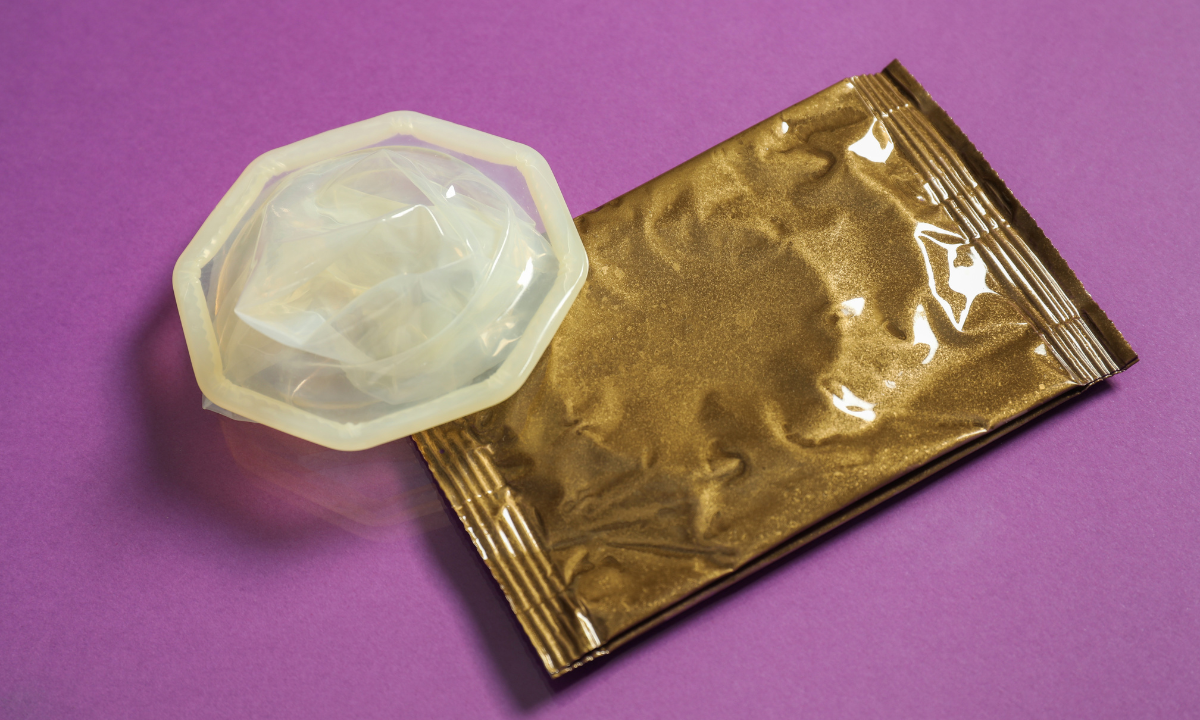Human immunodeficiency virus (HIV) is a virus that attacks the immune system and can cause AIDS if not treated. Using condoms is one of the most effective and reliable ways to reduce HIV transmission during sexual activity. However, they only work if you use them correctly and consistently.
Can condoms prevent HIV?
Yes, condoms reduce the risk of HIV transmission during vaginal, oral, and anal sex by preventing your semen, vaginal fluids, or blood from entering your partner’s body. A recent review from the National Institutes of Health (NIH) found that using condoms every time you have sex lowers the chance of getting HIV by up to 95%.
Condoms cannot guarantee 100% HIV prevention, but they provide strong protection if you use them correctly and consistently.
External condoms
External condoms, also known as male condoms, go over the penis and stop your body fluids from getting into your partner during sexual activity, and vice versa. They are one of the most reliable methods to lower your risk of getting HIV and most other sexually transmitted infections (STIs).
External condoms usually are made of latex, polyurethane, polyisoprene, or natural membrane. Polyurethane or polyisoprene condoms are good options if you have latex allergies, although they tend to break more often than latex condoms. Natural membrane condoms, such as those made from lambskin, have small holes and should not be used to prevent HIV or other STIs.
You can easily find latex, polyurethane, or polyisoprene condoms in pharmacies, clinics, and online.
How to use an external condom correctly?

To get the most protection, you need to know how to use an external condom correctly. Follow these steps every time you have sex.
Check the package:
Make sure the condom isn't broken or out of date.
Open carefully:
Tear the package along the edge, avoiding sharp objects such as teeth or nails.
Pinch the tip:
Leave a small space at the tip to collect semen and lower the risk of breaking.
Roll onto the hard penis:
Before any genital contact happens, roll the condom all the way down.
After ejaculation:
Hold the base of the condom while pulling out to keep it from coming off.
Dispose properly:
Wrap the used condom in tissue and throw it away. Don’t flush it down the toilet because this can cause blockages.
Internal condoms

Internal condoms, sometimes called female condoms, are designed to be worn inside the vagina or anus to keep you safe during sex. These condoms, which are made of nitrile or latex, line the inside walls and prevent contact with semen and other bodily fluids.
If you or your partner can't use external condoms because of allergies, sensitivity to latex, or personal preference, internal condoms are a good option. They also give you control over your sexual health. You can still protect yourself even if your partner doesn't want to wear a condom.
How to use an internal condom correctly?
By following these steps, you can get the most effective protection against HIV and other STIs.
Check the package:
Make sure the condom isn't expired, damaged, or torn.
Squeeze the inner ring:
Compress the closed end of the condom and gently insert it deep into the vagina or anus.
Get in the right position:
Make sure the outer ring stays outside and covers the whole area around the external genitalia.
Guide during intercourse:
Ensure the penis goes into the condom correctly and doesn't get stuck between the condom and the vaginal or anal walls.
Remove carefully:
After sex, twist the outer ring to seal in fluids, then gently pull the condom out. Put it in the trash where it will be safe.
If you are unsure about how to choose the right condom for yourself or your partner, or about how to use it correctly,schedule an appointmentwith Thomson Medical today for a personalised consultation with our O&G healthcare experts.
Do external and internal condoms provide equal HIV protection?
When used properly, both external and internal condoms protect against HIV and other STIs in the same way.
External condoms are more popular and have been studied a lot, so we know for sure that they work. Internal condoms are not used as often, but they are also a reliable barrier that lowers the risk of HIV transmission.
The type of condom is not the only thing that matters for protection. You also need to use it correctly and consistently every time you have sex. Putting the condom on after genital contact, slipping, or breaking it can make it much less effective.
Therefore, to get the best protection, you need to know how to use both external and internal condoms the right way.
Our O&G specialists
Loading...
Does spermicide provide extra protection against HIV?
No, spermicides, like nonoxynol-9, do not provide extra protection against HIV – and they actually increase your risk.
Spermicides are made to stop or kill sperm, but they don't work against viruses like HIV. In fact, using spermicides often or over and over again can irritate the vagina or rectum, cause small cuts, or inflammation, which may make it easier for HIV to enter the body.
For these reasons, it is best to use condoms that do not contain spermicide to prevent HIV.
Are there any risks of using condoms to prevent HIV?

Most of the time, condoms are very safe and are one of the most effective ways to stop HIV and other STIs from spreading. But there are a few things that could go wrong.
Breakage or slippage
Risk level:
Condom breakage or slippage during sexual intercourse has been reported in approximately 2% of cases.
Causes:
Incorrect condom use
Using a condom that is too small
Out-of-date condom
How to reduce the risk:
To lower this risk, it is very important to choose the correct size for you and your partner, and follow the right steps for using condoms.
What to do if it happens:
If a condom breaks or slips off, you should stop having sex and put on a new condom before continuing.
Then, consult a healthcare professional and consider getting tested for HIV and other STIs to ensure your sexual health is protected.
Allergic reactions
Risk level:
Latex allergies may occur in around 4.3% of the world’s population.
Cause:
Latex comes from the milky sap of rubber trees, which contains proteins that can cause allergic reactions.
Symptoms:
Signs of a latex allergy may appear during or after sexual activity and can include itchiness, swelling, redness, rashes, or discomfort in the genital area.
What to do if it happens:
You should consult a doctor for accurate diagnosis.
Polyurethane or nitrile condoms are good options that offer the same level of protection.
Reduced sensation
You may have less sensitivity, which can lead to inconsistent or incorrect use.
Even though there are some small problems, the benefits of using condoms far outweigh the risks.
If you are worried about the risks of using condoms or have experienced any problems, Thomson Medical is here to help you.Schedule an appointment with our O&G specialist for personalised recommendations.
FAQ
Do condoms stop HIV 100% of the time?
There is no sure way to avoid HIV, but condoms work very well to lower the risk. If you use condoms correctly and every time, they can stop the spread of HIV with an effectiveness of up to 95%. Putting the condom on before any genital contact, using it during sex, and making sure it doesn't slip or break are all parts of correct use.
What are five ways to stop HIV?
HIV prevention is most effective when using combination of different methods:
Using condoms consistently and correctly during vaginal, anal, or oral sex.
Regular HIV testing and knowing your own and your partner's HIV status.
Pre-exposure prophylaxis (PrEP) for people at high risk of exposure to HIV.
Avoiding sharing needles or other injecting equipment.
Safe medical procedures and blood transfusions, ensuring sterile equipment and screened blood products.
How often do condoms prevent HIV?
According to research, using condoms correctly and consistently can lower the risk of HIV transmission by 95%, but only if they are used correctly. Using them wrong or only sometimes makes them much less effective.
What diseases do condoms not completely prevent?
Condoms are great at preventing HIV and a lot of other sexually transmitted diseases (STD), but they can't completely stop infections that spread through skin-to-skin contact, especially if the area is not covered. Examples include:
Genital herpes
Syphilis (if sores are outside the area covered by the condom)
Why do condoms not always work?
The most common reason condoms don't work is that they aren't used correctly or consistently. This includes not using a condom from start to finish, using it wrong, or breaking or slipping during sex. Following the right steps every time is important to make sure you are as safe as possible.
Can viruses pass through condoms?
No. HIV and most viruses can't get through latex, polyurethane, or polyisoprene condoms. Viral transmission can only occur if the condom is used incorrectly, damaged, or breaks during intercourse. Correct use effectively stops viral exposure.
The information provided is intended for general guidance only and should not be considered medical advice. For personalised recommendations and tailored advice, please consult a specialist at Thomson Medical. Request an appointment with Thomson Medical today.
For more information, contact us:
Thomson Specialists (Women's Health)
Thomson Women's Clinic (TWC)
- Novena:
6592 6686 (Call), 8611 8986 (WA) - Bukit Batok:
6569 0668 (Call), 8686 3525 (WA) - Choa Chu Kang:
6893 1227 (Call), 8282 1796 (WA) Jurong:
6262 8588 (Call), 6262 8588 (WA)- Katong (female doctor):
6970 2272 (Call), 8611 9020 (WA) - Punggol:
6243 6843 (Call), 8811 0328 (WA) - Sembawang: 6753 5228
- Sengkang: 6388 8125
- Serangoon (female doctor): 6382 3313
- Tampines: 6857 6266
- Tiong Bahru: 6276 1525
